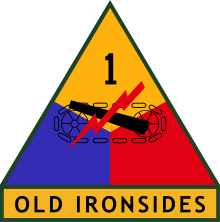15th Army Group
| 15th Army Group | |
|---|---|
 15th Army Group Shoulder Insignia | |
| Active | 1943–45 |
| Country |
United Kingdom & United States, numerous Allies attached |
| Allegiance | Allies of World War II |
| Type | Army group |
| Role | Army Group Headquarters |
| Size | 300,000 |
| Commanders | |
| Notable commanders |
Harold Alexander Mark W. Clark |
The 15th Army Group was an Army Group consisted by the British Eighth and the U.S. Fifth Armies, which apart from troops from the British Empire and U.S.A., also had whole units from other allied countries/regions; like 2 of their Corps (from free France and Poland), 1 Division (from Brazil) and 7 Brigades (6 Italian and one Greek), besides supporting and being supported by the local Italian partisans. It operated in the Italian Campaign during the WWII, between 1943-45.[1]
History
The 15th Army Group was activated in 1943 in Algiers, North Africa, to plan the invasion of Sicily, codenamed Operation Husky. Its main forces for this job were the U.S. Seventh Army, under Lieutenant General George Patton, and the British Eighth Army, under General Bernard Montgomery. Following the capture of Sicily, the army group became responsible for the invasion of mainland Italy for which the U.S. Seventh Army was replaced by the U.S. Fifth Army, under Lieutenant General Mark Clark. In January 1944, the army group was re-designated successively Allied forces in Italy and then Allied Central Mediterranean Force.
In March 1944, the army group was renamed Allied Armies in Italy. Throughout this period, the army group was under command of the British General Sir Harold Alexander. By late 1944, the army group had pushed northward through Italy, capturing Rome, and driving the retreating Axis forces into Northern Italy. Despite and due to the rapid advance of the Allied forces in Italy in June–July 1944, after the liberation of Rome, the high allied command in Western Europe decided to take away from the Italian front the French Expeditionary Corps and the U.S. VI Corps, reassigned for landing in the South of France in support of the advance in the north of that country, which was occurring slowly and unsatisfactorily in relation to the expectations of the western allies. The gap in the ranks of the U.S. Fifth Army caused by the withdrawal of seven divisions was only slowly filled by one Brazilian and three American divisions in late 1944 and early 1945.[2]
In order to complicate the Allied ambitions in Italy, between October 1944 and March 1945, the British VIII Army was also weakened by the withdrawal of the Greek brigade and the Canadian Corps, dispatched respectively to Greece and Netherlands. The new gap on the Italian front was filled by four Italian and one Jewish-Palestinian brigades.[3]
In December 1944, American Lieutenant General Mark Clark had became the new commander and the army group was renamed 15th Army Group once again.
After the definitive break up of the Gothic Line, the Axis forces in Italy were finally defeated in the army group's spring offensive, with their surrender taking place on 2 May.
On 5 July, 15 Army Group was reorganized and redesignated the U.S. Occupational Forces Austria. The Headquarters Company II Corps, 11th Armored Division, 42nd Infantry Division and 65th Infantry Division, previously assigned to U.S. Third Army and 12th Army Group, were assigned on 6 July to the newly formed U.S. Occupational Forces Austria, the commanding general of which was General Mark Clark.
Order of battle
Order of Battle for 15th Army Group, August 1944-April 1945


- British V Corps (Lieutenant-General Charles Keightley)


- 4th Indian Infantry Division - (Major-General Arthur Holworthy)


- British 25th Tank Brigade






- 10th Indian Infantry Division - (Major-General Denys Reid)
- British 9th Armoured Brigade
- Italian Co-belligerent Army - (Lieutenant General Paolo Berardi)
- British V Corps (Lieutenant-General Charles Keightley)










.svg.png)
.svg.png)
- British XIII Corps - (Lieutenant-General Sidney Kirkman)


- 8th Indian Infantry Division - (Major-General Dudley Russell)
- Army Group Reserve

- Italian resistance movement
Bibliography
Doherty, Richard. "Victory in Italy, 15th Army Group's Final Campaign 1945" Pen & Sword Books Ltd 2015 ISBN 9781783462988